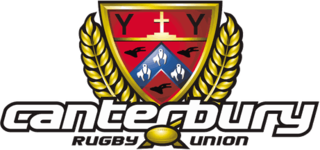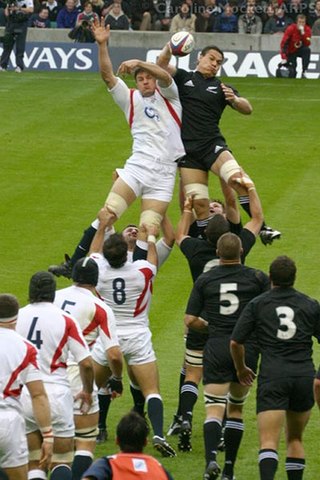Related Research Articles

Temuka is a town on New Zealand's Canterbury Plains, 15 kilometres north of Timaru and 142 km south of Christchurch. It is located at the centre of a rich sheep and dairy farming region, for which it is a service town. It lies on the north bank of the Temuka River, just above its confluence with the Ōpihi River.

The Canterbury Rugby Football Union is the governing body for rugby union in a portion of the Canterbury region of New Zealand. Its colours are red and black in a hooped design. The CRFU govern the running of the Canterbury representative team which have won New Zealand's first-tier domestic competition National Provincial Championship 14 times including a "six-peat" from 2008 to 2013 – with five in the National Provincial Championship, two in the Air New Zealand Cup, five in the ITM Cup and one in the Mitre 10 Cup. Their most recent victory was the 2017 Mitre 10 Cup. Canterbury also acts as a primary feeder to the Crusaders, who play in the Super Rugby competition.

Rugby union has been played in New Zealand since 1870 and is the most popular sport in the country as well as being its national sport.

Duncan McGregor, was a New Zealand rugby union and rugby league footballer. He was a member of the legendary 1905 Original All Blacks and later converted to rugby league when he went on the 1907 New Zealand league tour of Britain and Australia. He stayed in Britain following the 1907–08 tour, and opened a sport store as well as playing for Merthyr Tydfil RLFC. He returned to New Zealand after five years and continued to be involved in rugby league as an administrator and official.
The South Canterbury Rugby Football Union (SCRFU) is a rugby province based in the central South Island city of Timaru, New Zealand. The South Canterbury team play at Fraser Park located in Timaru.

The Buller Rugby Union (BRU) is a rugby union province based in the town of Westport, New Zealand. The Buller provincial boundary also includes other notable towns such as Reefton, Karamea, Granity, Charleston, Punakaiki and Murchison.

Timaru Boys' High School, established in 1880, is a single sex state (public) secondary school located in the port city of Timaru, South Canterbury, New Zealand. TBHS caters for years 9 to 13.

Vincent David Bevan was a New Zealand rugby union player.
Colin "Col" Windon, was a rugby union player and soldier who captained Australia – the Wallabies – in two Test matches in 1951. By age 18 Windon was playing at flanker for his club Randwick in Sydney's Shute Shield. After serving with the Second Australian Imperial Force in the Pacific Theatre during the Second World War, Windon resumed his rugby career in 1946. He was first selected for Australia for their tour of New Zealand that year. Despite the Wallabies losing both their Tests on tour, Windon impressed with his play.
James Scott Haig was a Scottish-born New Zealand rugby footballer who represented New Zealand in both rugby league and rugby union.
Daniel Henry Verner Du Vall was a New Zealand professional rugby league footballer who played in the 1910s. He played at representative level for New Zealand, and Hawke's Bay, as a Centre, i.e. number 3 or 4.

Rugby union has a long history in New Zealand. Today, New Zealand holds tier one status with World Rugby.
Walter Garland Argus was a New Zealand rugby union player who played 10 matches including four tests for the national team. From 16 November 2012 until his death he was the oldest living All Black.
Charles Nicholson Macintosh was a New Zealand rugby union player and politician. He served as Mayor of Timaru between 1901 and 1902.
Gordon Pirie Lawson was a New Zealand rugby union player. He was educated at Timaru Main School and then Timaru Boys' High School. A first five-eighth, Lawson representedSouth Canterbury at a provincial level, and was a member of the New Zealand national side, the All Blacks, on their 1925 tour of New South Wales. He played just two matches on that tour, and did not appear in any test matches for the All Blacks.
Augustine Patrick Spillane was a New Zealand rugby union player. Gus Spillane came from a Temuka rugby family of Irish descent and one steeped in rugby. Three of his brothers also represented South Canterbury with one, Charles, later moving to Wanganui and Taranaki and becoming prominent in refereeing and administration. The Spillane Cup, the traditional trophy competed for at Easter by North Island Marist clubs, is named after Charles Spillane. Primarily a tidyfirst five-eighth, Spillane represented South Canterbury at a provincial level, and was a member of the New Zealand national side, the All Blacks, in 1913. He appeared in two matches for the All Blacks, both of them internationals against the touring Australian team, in which he played at second-five eighth.
Thomas Norman Lister was a New Zealand rugby union player who represented the All Blacks between 1968 and 1971. His position of choice was flanker.
Percival Wright Storey was a New Zealand rugby union player. A wing three-quarter, Storey represented South Canterbury at a provincial level, and was a member of the New Zealand national side, the All Blacks, from 1920 to 1921. He played 10 matches for the All Blacks including two internationals, scoring a total of 50 points.
The South Canterbury cricket team represents the South Canterbury region of New Zealand. It competes in the Hawke Cup. Its headquarters are at Aorangi Oval in Timaru, where South Canterbury play most of their home matches.
Eric George Boggs was a New Zealand rugby union player and coach. He was a winger in the New Zealand national rugby union team, the All Blacks, in 1946 and 1946, and later coached Ponsonby and the Auckland provincial side. A schoolteacher by training, he was also principal of a number of primary and intermediate schools in Auckland.